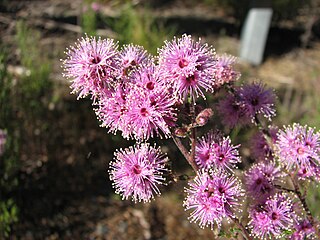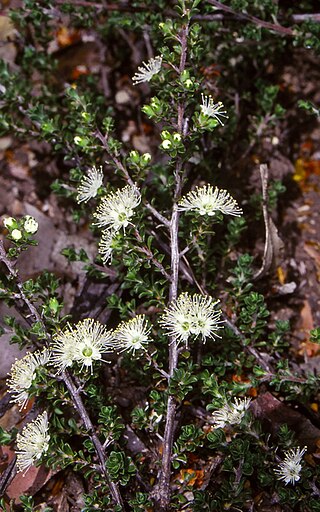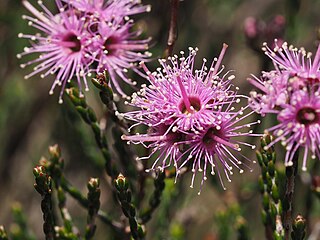
Kunzea pomifera, commonly known as muntries, emu apples, native cranberries, munthari, muntaberry or monterry, is a low-growing or prostrate shrub with hairy stems, small, mostly egg-shaped leaves, groups of white flowers on the ends of the branches and fleshy, more or less spherical, edible fruit.

Kunzea pulchella, commonly known as granite kunzea, is a flowering plant in the myrtle family, Myrtaceae and is endemic to the south-west of Western Australia. It is a shrub with spreading branches, egg-shaped to lance-shaped leaves and loose groups of red flowers, each on a short stalk so that the branch is visible between the flowers.

Kunzea baxteri, commonly known as scarlet kunzea, is a flowering plant in the myrtle family Myrtaceae, and is endemic to the south-west of Western Australia where it occurs near granite outcrops and hills. It is a shrub with large, scarlet, bottlebrush-like flower clusters, making it popular as a garden feature.

Boronia muelleri, commonly known as the forest boronia or pink boronia, is a flowering plant that occurs in forest, woodland and heath in Victoria and New South Wales in Australia. It is an erect, woody shrub or small tree with pinnate leaves and up to fifteen pink to white four-petalled flowers arranged in leaf axils in spring and summer.

Pultenaea muelleri, commonly known as Mueller's bush-pea, is a species of flowering plant in the family Fabaceae and is endemic to Victoria, Australia. It is a dense shrub with hairy stems, elliptic to narrow egg-shaped leaves with the narrower end towards the base, and yellow and red flowers arranged singly or in pairs on the ends of short side shoots.

Kunzea parvifolia, commonly known as the violet kunzea, is a flowering plant in the myrtle family, Myrtaceae and is endemic to eastern Australia. It is a wiry shrub with small, narrow leaves and clusters of pink to purple flowers in spring.

Kunzea axillaris is a flowering plant in the myrtle family, Myrtaceae and is endemic to a small area of New South Wales. It is an erect shrub or tree with linear leaves and white flowers which are arranged singly in leaf axils. It is only known from the ranges on the north coast.

Kunzea obovata is a flowering plant in the myrtle family, Myrtaceae and is endemic to eastern Australia. It is a spreading shrub with unusually-shaped leaves and clusters of pink to purple flowers. It is restricted to northern New South Wales and south-eastern Queensland.

Kunzea badjaensis is a flowering plant in the myrtle family, Myrtaceae and is endemic to a small area of New South Wales. It is a shrub with egg-shaped leaves and clusters of white flowers near the end of the branches. It grows at high altitudes on the Southern Tablelands.
Kunzea calida is a plant in the myrtle family, Myrtaceae and is endemic to Queensland, Australia. It is a spreading shrub which has linear to lance-shaped leaves but which are rolled, making them appear cylindrical. The flowers are pinkish-purple and arranged in groups near the ends of the branches in September. It is only known in remote and rugged areas of the Mount Stewart Ranges near Homestead.

Kunzea cambagei, commonly known as the Cambage kunzea is a flowering plant in the myrtle family, Myrtaceae and is endemic to a small area of New South Wales. It is a small shrub with egg-shaped leaves and clusters of cream-coloured to yellowish flowers near the end of the branches. It is only known from areas near Mount Werong in the Kanangra-Boyd National Park and Berrima.
Kunzea dactylota is a flowering plant in the myrtle family, Myrtaceae and is endemic to a small area of New South Wales. It is a spreading shrub with small, finger-shaped leaves and clusters of white flowers near the end of the branches. It grows at high altitudes on the Southern Tablelands of the state.

Kunzea flavescens is a plant in the myrtle family, Myrtaceae and is endemic to Queensland. It is a spreading shrub which has egg-shaped leaves and groups of white or cream-coloured flowers on the ends of the branches in September and October.
Kunzea juniperoides is a flowering plant in the myrtle family, Myrtaceae and is endemic to a small area of New South Wales. It is a small shrub with narrow leaves and small groups of white flowers near the end of the longer branches. It is distinguished from similar kunzeas by the large number of scale-like perules and bracts surrounding the groups of flowers.

Kunzea occidentalis is a flowering plant in the myrtle family, Myrtaceae and is endemic to a western New South Wales. It is a shrub with narrow leaves and small groups of white flowers on leafy side-branches. It is distinguished from the similar Kunzea ambigua by the flanges on the sides of its young branches.

Kunzea opposita is a plant in the myrtle family, Myrtaceae and is endemic to eastern Australia. It is a spindly shrub which has small leaves arranged in opposite pairs, and pink flowers with five petals and many stamens, the stamens much longer than the petals. It usually grows in woodland or on exposed cliffs.
Kunzea petrophila is a flowering plant in the myrtle family, Myrtaceae and is endemic to the Northern Territory. It is a spreading shrub with hairy branches and leaves, narrow leaves and cream-coloured flowers in more or less spherical groups, usually on the ends of the main branches.
Philotheca ericifolia is a species of flowering plant in the family Rutaceae and is endemic to New South Wales. It is a much-branched shrub with glandular-warty branchlets, needle-shaped leaves and white to pink flowers arranged singly or in groups of up to six on the ends of the branchlets.

Pultenaea reflexifolia, commonly known as wombat bush-pea, is a species of flowering plant in the family Fabaceae and is endemic to isolated parts of Victoria. It is an erect shrub with its foliage covered with tangled hairs, and has elliptic to narrow egg-shaped leaves with the narrower end towards the base, and yellow and red pea-like flowers arranged singly or in pairs on the ends of short side branches.

Olearia muelleri, commonly known as Mueller daisy bush, Mueller's daisy bush or Goldfields daisy, is a species of flowering plant in the family Asteraceae and is endemic to southern continental Australia. It is a compact or spreading shrub with scattered spatula-shaped to egg-shaped leaves with the narrower end towards the base, and white and yellow, daisy-like inflorescences.















